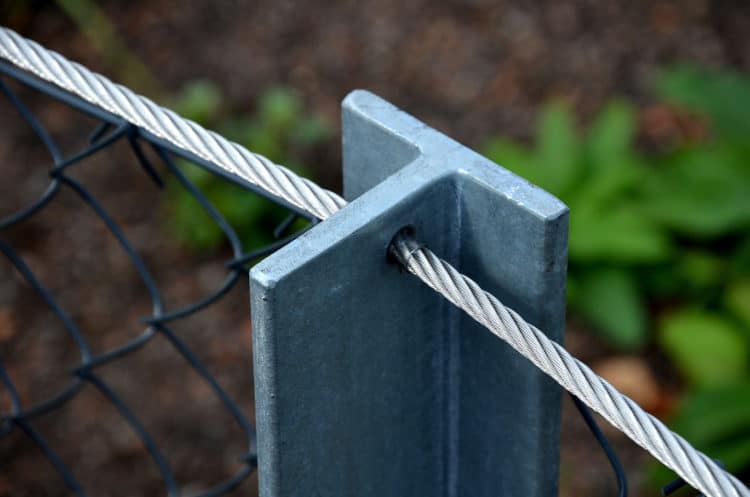When you want to support wire fencing to protect your livestock or mark property boundaries, a T-post installation is a cheap, easy, and straightforward option.
You’ll need wooden fence posts for the corners with bracing to ensure that you have a solid line installed. That means you’ll need to set them in concrete and gravel before pounding in the T-posts.
Once you have that step completed, you’ll need to position the studs to the inside or outside. They should face inward to prevent livestock from putting pressure on the installation. If you need to protect your animals from predators, they should face to the outside.
How Do You Pound Your T-Posts Straight?
The first step to pounding a T-post straight is to have your corners set and braced. Run a guided line to ensure you achieve a desirable line. Each post should be between 8 to 12 feet apart. Position each one with the anchor plate at the bottom and perpendicular to the fence. Drive from a vertical position.
Each T-post should get driven into the ground to a depth of at least 18 inches. It is often necessary to get to two feet with this work, burying the anchor entirely, to avoid the posts from getting pulled out of the soil.
It also helps to keep referring to your fence line as you work to ensure the installation stays straight. Don’t try to eyeball everything because your reference points don’t always line up.
You’re almost guaranteed to have a crooked installation when using that methodology.
As you start stringing the wire along the fence posts, review your attachments to ensure they’re secured to the studs. If they can move up or down, that means they could pull away from the T-posts.
Before you start this work in a suburban or urban setting, please remember to call 811 (or an equivalent number) to have the underground lines marked. It can be costly to damage cables, pipes, or gas lines.
T-Post Recommendation: Chicago Heights Steel Studded Post
When you need tough fencing applications for your home or business, the Chicago Heights Steel Studded T-Post delivers a robust result. It’s one of the sturdiest options you’ll find today, offering a minimum yield point of 50,000 PSI. That means the tensile strength of this product tops 80,000 PSI, creating a sturdy and reliable outcome.
The steel studded T-Posts have the same resilience and strength as the support rails created for trains. You’ll receive five clips included with your purchase of this six-foot post, matching the five items you can install to complete your fence.
You’ll find that these T-Posts from Chicago Heights are just as good as anything you can get locally. Instead of shopping at the feed store, why not have them delivered directly to your address?
Post Driver Recommendation: MTB Fence Post Driver
You’ll receive a single solid round pipe post driver with two handles with this product design. It’s about two feet long, making it easy to see how far you’ll need to drive the T-post in when measuring it from the bottom before beginning.
The heavier weight of the MTB Fence Post Driver that makes it stand out from other designs. If you can get the unit over the post’s top, it will help you to the rest of the work to secure the T-post for your fence. The 12-pound drive weight is reasonable for most ages and abilities. It even comes with a black powder-coated finish to resist chipping, corrosion, and fading.
Since it can be relatively heavy to lift over your head when starting a T-post, try sliding it on top while the post is still on the ground. Once accomplished, you can raise both to a vertical position to start the driving work.
Barbed Wire Fencing Recommendation: OrangeA Razor Wire
You’ll receive 500 feet of razor wire with this item, creating a lengthy triple-strand fence with your T-posts. Each coil you receive is designed to produce 50 linear feet, although expanding beyond 33 feet with the circular installation pattern limits its effectiveness. It’s suitable for all property types, ranging from garden protection to military sites.
The OrangeA Razor Wire is a galvanized product that typically serves as a perimeter on top of standard barbed lines, although you can stretch it out to be your primary fencing.
If you decide to use this product, you’ll want to invest in no-slash sleeves and gloves to prevent a potential injury. It is super sharp, ensuring that you receive the deterrent effect you want.
How to Keep Your T-Posts Plumb
The primary reason why T-Posts come out less than vertical involves the individual’s height. When you have a 6-foot post to drive with some added size needed to move the driver up and down, anyone in the 5-foot-something range ends up pulling on the top instead of getting a straight drive.
It’s that pulling action that creates the crookedness that becomes problematic for fencing. The best way to solve that issue is to get a chair or stepladder to stand on while driving the post.
Since you’ll be at height, even if it is only a couple of feet, it helps to have a spotter available who can secure your platform.
If the weight of a standard T-post driver is too much, a spring-loaded version could be an investment to consider. It’s much easier to use, producing most of the force itself to create a positive outcome. Should that item be too heavy, a two-stroke-powered driver will give you the result you want.
When you’re driving a T-post into hard ground, it’s actually easier to start the process with a sledgehammer. If you slam a driver repetitively, the vibration and jarring at the handles can hurt your hands and wrists. You’ll still need to be higher to make this effort work.
If you don’t have a way to get higher than the post and driver, you’ll need to dig out a small hole for the post. You can fill the area with water to soften things up for those times when progress isn’t getting made.
It also helps to invest in high-quality T-posts. When you have one made with exclusive steel products, the vertical driving work is much easier to complete.
Some Posts Won’t Go in Straight No Matter What I Do!
The manufacturing process for steel T-posts can sometimes cause them to drive down out of plumb even when you’ve used your equipment correctly. If you take a look at most of today’s cheaper posts, you’ll see a twist that gets built into the product.
That doesn’t mean the post itself has become crooked. When one of the ribs starts to cool at a different pace than the rest of the metal, it can cause a slight bend. That causes the T-post to twist when driving it vertically.
You’ll notice that some posts seem to twist naturally when driving them into the ground. It doesn’t matter what soil type you have with this issue. Eventually, you’ll reach a point where that problem no longer happens.
The twist always occurs in the same direction when facing this issue. If you start working from the opposite direction, you can time the driving to create a plumb installation.
When you 100% need a plumb T-post for your fence, the best option is to float it with concrete to create a solid installation.
You Can Use the Driverless Method to Create a Positive Result
If the driving work creates crooked lines with your T-posts, it might be better to use a driverless method to make your fencing.
The first step is to make a deep hole where the post should go. It will need to be about 18 inches in depth to have a satisfactory experience, and you’ll want to keep the width to a minimum.
Once you have the depth right, it helps to fill the hole with water until the ground becomes soft all the way down. If you’ve been in a drought or the soil is rocky and rugged, you might need to give it an overnight soak and come back for another watering in the morning.
After the soil softens, you can manually press the T-post into the ground. Use hard-soled shoes to step on the fins, pushing them through the hole into the earth. Once it is secure, pound the top of the post with a hammer to give it a plumb installation.
Once the T-post is secure, you can move it to the plumb position. If you need to use a driver, get the post into the ground, and adjust as necessary to create a manual outcome.
As long as you take your time, start with a straight line, and get your placements even, you can bend the posts to the spot where you want them.
After you set your corners and get all the T-posts installed, you can start the fencing work to create the desired barrier. If you don’t have clips to use with your barbed wire, you can wrap the fencing around the post a couple of times to get it taut.
Would a U-Post Be Better Than a T-Post?
The primary difference between U-posts and T-posts is the shape. You’ll find more of a cupped post with the first option, which means they have fewer wire attachment points to consider. That’s why a U-post is about 50% of the cost of a standard T-post.
The animals you want to protect with this fencing option dictate the post type to select when using barbed wire or similar barriers. It’s better to use a U-post with ponies or goats to prevent them from hurting themselves on the posts. They’re also thicker, which means they have more strength to offer if an animal leans against them.
If you need more earth-grasping strength, a T-post delivers a better overall result. They’re long-lasting, easily reusable, and heavy enough to stop predators. It’s also much easier to catch your wire on this design.
The final step of the installation process is to strengthen your post. How you accomplish this task depends on local conditions.
You might need to add more wires or stakes around each post base to prevent it from becoming shaky or weak. As your fencing gets higher, you’ll need additional support since the weight that catches at the top could tear out the installation.
Driving a T-post straight might seem like an impossible task, but it is doable with a few adjustments. If you need to bend it to make it plumb, please remember to firm up the ground and add supports as necessary.

